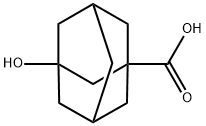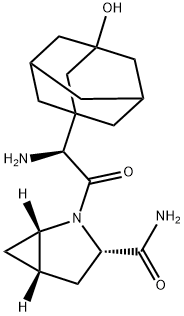3-Hydroxy-1-AdaMantane Carboxylic Acid
Synonym(s):1-Carboxy-3-adamantanol;3-Carboxy-1-hydroxyadamantane;3-Hydroxytricyclo[3.3.1.13,7]decane-1-carboxylic acid
- CAS NO.:42711-75-1
- Empirical Formula: C11H16O3
- Molecular Weight: 196.24
- MDL number: MFCD00193929
- SAFETY DATA SHEET (SDS)
- Update Date: 2025-09-20 20:09:13

What is 3-Hydroxy-1-AdaMantane Carboxylic Acid?
Chemical properties
White to yellow solid
The Uses of 3-Hydroxy-1-AdaMantane Carboxylic Acid
3-Hydroxy-1-AdaMantane Carboxylic Acid is used in the synthesis of potent pyridyl amide/sulfonamide inhibitors of 11β-HSD-1 which could be applied to a treatment of ulcers or in hormone therapy treatments relating t o cortisol.
The Uses of 3-Hydroxy-1-AdaMantane Carboxylic Acid
1-Carboxy-3-adamantanol is used in the synthesis of potent pyridyl amide/sulfonamide inhibitors of 11β-HSD-1 which could be applied to a treatment of ulcers or in hormone therapy treatments relating to cortisol.
Synthesis Reference(s)
Synthetic Communications, 18, p. 1967, 1988 DOI: 10.1080/00397918808068263
Properties of 3-Hydroxy-1-AdaMantane Carboxylic Acid
| Melting point: | 203 °C |
| Boiling point: | 357.2±25.0 °C(Predicted) |
| Density | 1.419±0.06 g/cm3(Predicted) |
| storage temp. | Sealed in dry,Room Temperature |
| solubility | DMSO (Slightly), Methanol (Slightly) |
| form | Solid |
| pka | 4.60±0.40(Predicted) |
| color | Off-White |
| InChI | InChI=1S/C11H16O3/c12-9(13)10-2-7-1-8(3-10)5-11(14,4-7)6-10/h7-8,14H,1-6H2,(H,12,13) |
| CAS DataBase Reference | 42711-75-1(CAS DataBase Reference) |
Safety information for 3-Hydroxy-1-AdaMantane Carboxylic Acid
| Signal word | Warning |
| Pictogram(s) |
 Exclamation Mark Irritant GHS07 |
| GHS Hazard Statements |
H302:Acute toxicity,oral H315:Skin corrosion/irritation H319:Serious eye damage/eye irritation |
| Precautionary Statement Codes |
P264:Wash hands thoroughly after handling. P264:Wash skin thouroughly after handling. P280:Wear protective gloves/protective clothing/eye protection/face protection. P305+P351+P338:IF IN EYES: Rinse cautiously with water for several minutes. Remove contact lenses, if present and easy to do. Continuerinsing. |
Computed Descriptors for 3-Hydroxy-1-AdaMantane Carboxylic Acid
| InChIKey | CJJMAWPEZKYJAP-UHFFFAOYSA-N |
| SMILES | C12(C(O)=O)CC3CC(CC(O)(C3)C1)C2 |
New Products
Indole Methyl Resin tert-butyl 9-methoxy-3-azaspiro[5.5]undecane-3-carboxylate Boc-His(Boc)-OH 2-CTC Resin 4-Chloro-7-tosy1-7Hpyrrolo[2,3-d]pyrimidine 5,7-Dibromo-1H-indole 2,5-dichloro-N-hydroxy-4,6-dimethylpyridine-3-carboximidamide 2,2-Dimethoxy-7-azaspiro[3.5]nonane hydrochloride 4-chloromethyl-5-methyl-1,3-dioxol-2-one (DMDO-Cl) R-2-BENZYLOXY PROPIONIC ACID 1,1’-CARBONYLDIIMIDAZOLE 1,1’-CARBONYLDI (1,2-4 TRIAZOLE) N-METHYL INDAZOLE-3-CARBOXYLIC ACID 4-((2-hydroxyethyl)thio)benzoic acid 1-(TERT-BUTOXYCARBONYL)-2-PYRROLIDINONE Methyl 6-methylnicotinate 3-Pyridineacrylic acid tert-Butyl carbazate TETRAHYDRO-2H-PYRAN-3-OL 2-((4-morpholinophenylamino) (methylthio) methylene) malononitrile 3-(4-morpholinophenylamino)-5-amino-1H-pyrazole-4-carbonitrile 2,4-dihydroxybenzaldehyde 1,3-Diethyl-1,3-Diphenylurea Methyl 2-methylquinoline-6-carboxylateRelated products of tetrahydrofuran

![Tricyclo[3.3.1.13,7]decane-1-acetic acid, α-[[(1,1-diMethylethoxy)carbonyl]aMino]-3,5-dihydroxy-, (αS)-](https://img.chemicalbook.in/CAS/20210111/GIF/681282-72-4.gif)

![2-Azabicyclo[3.1.0]hexane-3-carbonitrile, 2-[(2R)-2-aMino-2-(3-hydroxytricyclo[3.3.1.13,7]dec-1-yl)acetyl]-, (1R,3S,5R)-](https://img.chemicalbook.in/CAS/20200611/GIF/1564265-98-0.gif)




You may like
-
 3-Hydroxy-1-adamantanecarboxylic Acid CAS 42711-75-1View Details
3-Hydroxy-1-adamantanecarboxylic Acid CAS 42711-75-1View Details
42711-75-1 -
 3-Hydroxyadamantane-1-carboxylic acid CAS 42711-75-1View Details
3-Hydroxyadamantane-1-carboxylic acid CAS 42711-75-1View Details
42711-75-1 -
 Pyridine 99.5% HPLC /UV SpectroscopyView Details
Pyridine 99.5% HPLC /UV SpectroscopyView Details
110-86-1 -
 Piperazine Spot supply, best priceView Details
Piperazine Spot supply, best priceView Details
110-85-0 -
 Dibutyl PhthalateView Details
Dibutyl PhthalateView Details
84-74-2 -
 Imidazole Spot supply, competitive priceView Details
Imidazole Spot supply, competitive priceView Details
288-32-4 -
 Octadecyl 3-(3,5-di-tert-butyl-4-hydroxyphenyl)propionate 98% (GC)View Details
Octadecyl 3-(3,5-di-tert-butyl-4-hydroxyphenyl)propionate 98% (GC)View Details
2082-79-3 -
 Thiourea 99% ARView Details
Thiourea 99% ARView Details
62-56-6
Statement: All products displayed on this website are only used for non medical purposes such as industrial applications or scientific research, and cannot be used for clinical diagnosis or treatment of humans or animals. They are not medicinal or edible.
